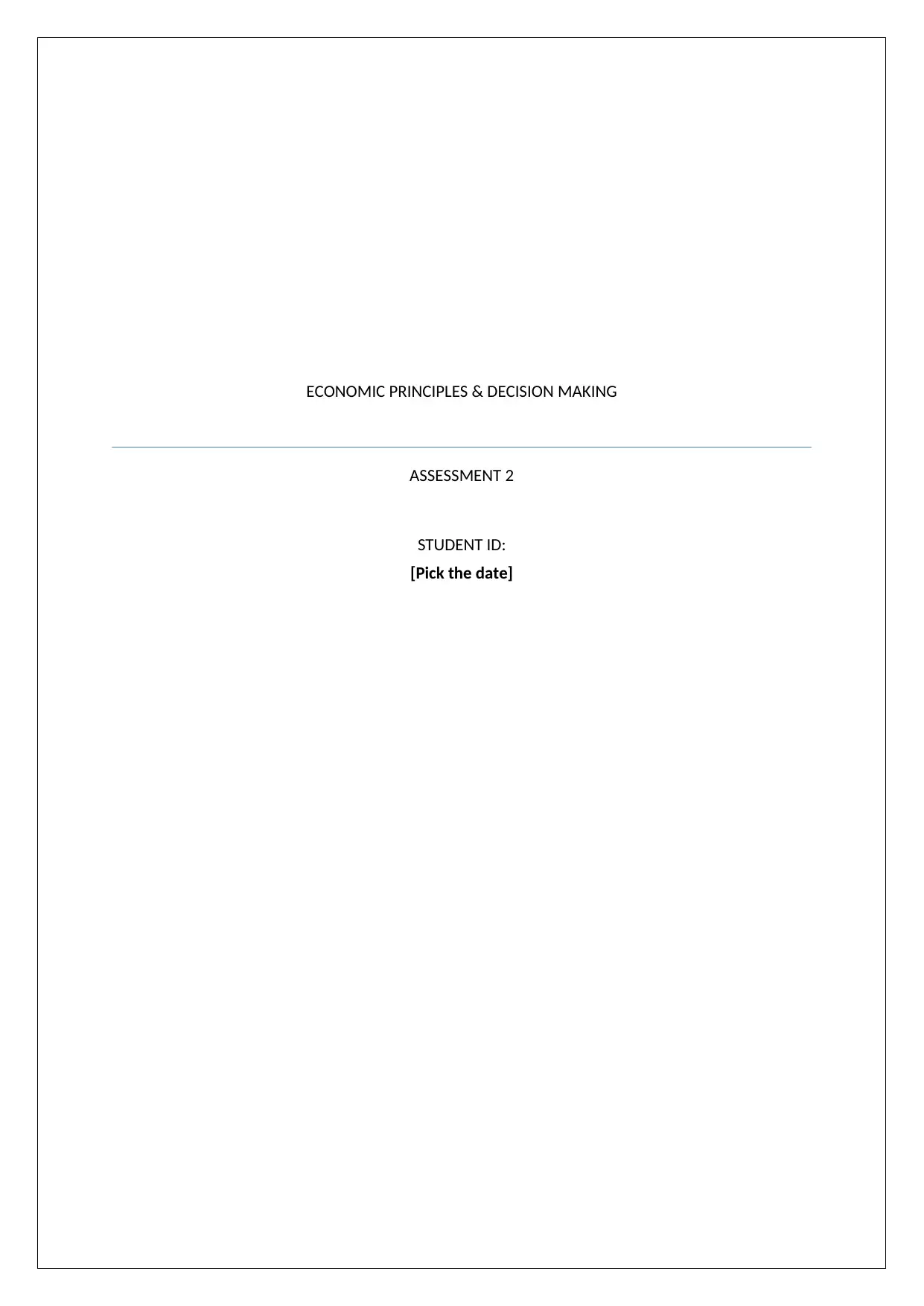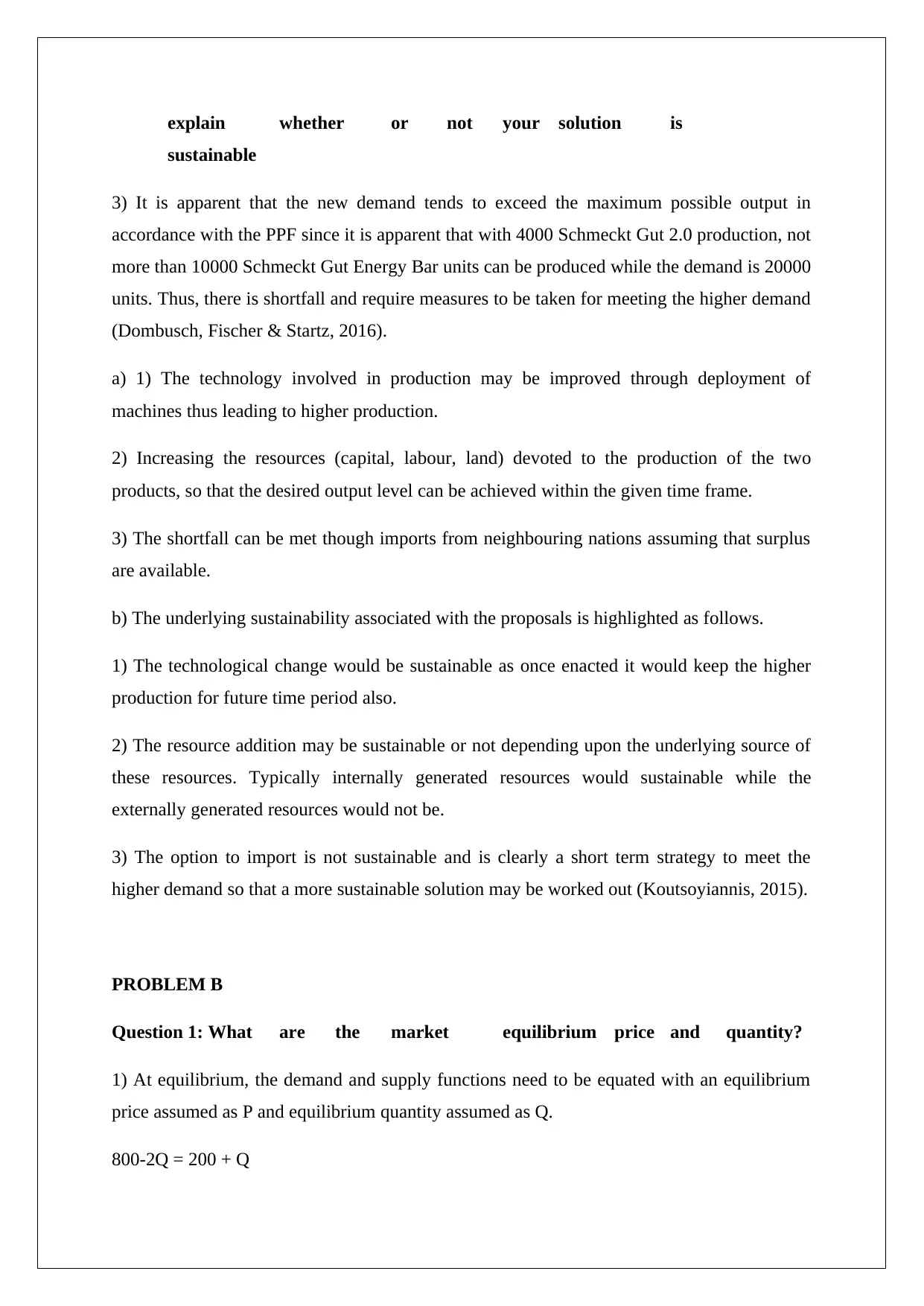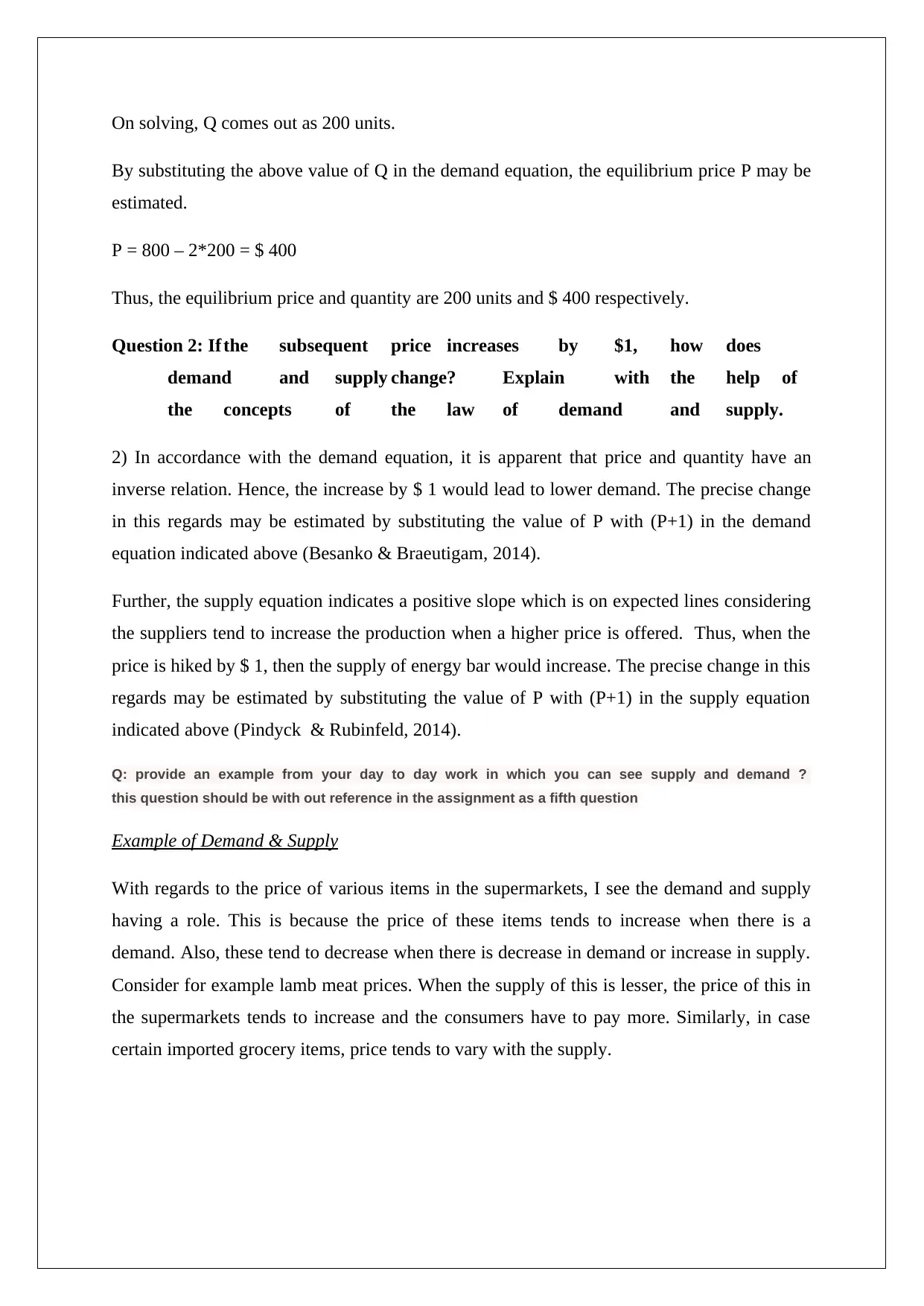Economic Principles & Decision Making (ECON6000) - Assessment 2
VerifiedAdded on 2023/06/04
|5
|1048
|69
Homework Assignment
AI Summary
This assignment solution for ECON6000 Assessment 2 analyzes economic principles and decision-making. Problem A examines the Production Possibilities Frontier (PPF) for Schmeckt Gut, exploring output combinations, demand changes, and sustainable solutions to meet increased demand. Problem B focuses on market equilibrium, determining price and quantity, analyzing the impact of price changes on supply and demand, and providing a real-world example of supply and demand dynamics. The solution includes graphical representations, calculations, and explanations of key economic concepts, referencing relevant academic sources. The assessment covers the interpretation of supply and demand, application of quantitative methods, analysis of production processes, and evaluation of market structures.

ECONOMIC PRINCIPLES & DECISION MAKING
ASSESSMENT 2
STUDENT ID:
[Pick the date]
ASSESSMENT 2
STUDENT ID:
[Pick the date]
Paraphrase This Document
Need a fresh take? Get an instant paraphrase of this document with our AI Paraphraser

PROBLEM A
Question: 1. Using the above figuresand Microsoft Excel, map out the
Production Possibilities Frontier (PPF) for the production of the
Schmeckt Gut Energy Bar and Schmeckt Gut 2.0.
1) The relevant PPF as drawn using Excel is shown as follows.
0 5000 10000 15000 20000 25000 30000 35000
0
1000
2000
3000
4000
5000
6000
Production Possibility Frontier
Schmeckt Gut Energy Bar
Scmeckt Gut 2.0
Question2: In your own words, while making use of the graph
that you have created in part 1, explain what the
PPF is.
2) It is representative of the possible output combinations for the two goods provided
assuming that the underlying resources are used optimally. Hence, with the resources at hand,
it is not possible to achieve any production level which lies outside the boundary indicated by
PPF. Thus, if one desires to produce more than 5000 units of Schmeckt Gut 2.0, then the
same canoe be achieved as it lies outside the PPF.
Question 3: District D usually has a demand of 3,000 Schmeckt
Gut 2.0 and 18,000 Schmeckt Gut Energy Bars.
Suddenly we receivenotice that the demand has increased
to 4,000 Schmeckt Gut 2.0 and 20,000 Schmeckt Gut
Energy Bars. a. Discuss and explain at least three
possibilities how we could meet that demand. b. For each
solution that you have identified and discussed above,
Question: 1. Using the above figuresand Microsoft Excel, map out the
Production Possibilities Frontier (PPF) for the production of the
Schmeckt Gut Energy Bar and Schmeckt Gut 2.0.
1) The relevant PPF as drawn using Excel is shown as follows.
0 5000 10000 15000 20000 25000 30000 35000
0
1000
2000
3000
4000
5000
6000
Production Possibility Frontier
Schmeckt Gut Energy Bar
Scmeckt Gut 2.0
Question2: In your own words, while making use of the graph
that you have created in part 1, explain what the
PPF is.
2) It is representative of the possible output combinations for the two goods provided
assuming that the underlying resources are used optimally. Hence, with the resources at hand,
it is not possible to achieve any production level which lies outside the boundary indicated by
PPF. Thus, if one desires to produce more than 5000 units of Schmeckt Gut 2.0, then the
same canoe be achieved as it lies outside the PPF.
Question 3: District D usually has a demand of 3,000 Schmeckt
Gut 2.0 and 18,000 Schmeckt Gut Energy Bars.
Suddenly we receivenotice that the demand has increased
to 4,000 Schmeckt Gut 2.0 and 20,000 Schmeckt Gut
Energy Bars. a. Discuss and explain at least three
possibilities how we could meet that demand. b. For each
solution that you have identified and discussed above,

explain whether or not your solution is
sustainable
3) It is apparent that the new demand tends to exceed the maximum possible output in
accordance with the PPF since it is apparent that with 4000 Schmeckt Gut 2.0 production, not
more than 10000 Schmeckt Gut Energy Bar units can be produced while the demand is 20000
units. Thus, there is shortfall and require measures to be taken for meeting the higher demand
(Dombusch, Fischer & Startz, 2016).
a) 1) The technology involved in production may be improved through deployment of
machines thus leading to higher production.
2) Increasing the resources (capital, labour, land) devoted to the production of the two
products, so that the desired output level can be achieved within the given time frame.
3) The shortfall can be met though imports from neighbouring nations assuming that surplus
are available.
b) The underlying sustainability associated with the proposals is highlighted as follows.
1) The technological change would be sustainable as once enacted it would keep the higher
production for future time period also.
2) The resource addition may be sustainable or not depending upon the underlying source of
these resources. Typically internally generated resources would sustainable while the
externally generated resources would not be.
3) The option to import is not sustainable and is clearly a short term strategy to meet the
higher demand so that a more sustainable solution may be worked out (Koutsoyiannis, 2015).
PROBLEM B
Question 1: What are the market equilibrium price and quantity?
1) At equilibrium, the demand and supply functions need to be equated with an equilibrium
price assumed as P and equilibrium quantity assumed as Q.
800-2Q = 200 + Q
sustainable
3) It is apparent that the new demand tends to exceed the maximum possible output in
accordance with the PPF since it is apparent that with 4000 Schmeckt Gut 2.0 production, not
more than 10000 Schmeckt Gut Energy Bar units can be produced while the demand is 20000
units. Thus, there is shortfall and require measures to be taken for meeting the higher demand
(Dombusch, Fischer & Startz, 2016).
a) 1) The technology involved in production may be improved through deployment of
machines thus leading to higher production.
2) Increasing the resources (capital, labour, land) devoted to the production of the two
products, so that the desired output level can be achieved within the given time frame.
3) The shortfall can be met though imports from neighbouring nations assuming that surplus
are available.
b) The underlying sustainability associated with the proposals is highlighted as follows.
1) The technological change would be sustainable as once enacted it would keep the higher
production for future time period also.
2) The resource addition may be sustainable or not depending upon the underlying source of
these resources. Typically internally generated resources would sustainable while the
externally generated resources would not be.
3) The option to import is not sustainable and is clearly a short term strategy to meet the
higher demand so that a more sustainable solution may be worked out (Koutsoyiannis, 2015).
PROBLEM B
Question 1: What are the market equilibrium price and quantity?
1) At equilibrium, the demand and supply functions need to be equated with an equilibrium
price assumed as P and equilibrium quantity assumed as Q.
800-2Q = 200 + Q
⊘ This is a preview!⊘
Do you want full access?
Subscribe today to unlock all pages.

Trusted by 1+ million students worldwide

On solving, Q comes out as 200 units.
By substituting the above value of Q in the demand equation, the equilibrium price P may be
estimated.
P = 800 – 2*200 = $ 400
Thus, the equilibrium price and quantity are 200 units and $ 400 respectively.
Question 2: If the subsequent price increases by $1, how does
demand and supply change? Explain with the help of
the concepts of the law of demand and supply.
2) In accordance with the demand equation, it is apparent that price and quantity have an
inverse relation. Hence, the increase by $ 1 would lead to lower demand. The precise change
in this regards may be estimated by substituting the value of P with (P+1) in the demand
equation indicated above (Besanko & Braeutigam, 2014).
Further, the supply equation indicates a positive slope which is on expected lines considering
the suppliers tend to increase the production when a higher price is offered. Thus, when the
price is hiked by $ 1, then the supply of energy bar would increase. The precise change in this
regards may be estimated by substituting the value of P with (P+1) in the supply equation
indicated above (Pindyck & Rubinfeld, 2014).
Q: provide an example from your day to day work in which you can see supply and demand ?
this question should be with out reference in the assignment as a fifth question
Example of Demand & Supply
With regards to the price of various items in the supermarkets, I see the demand and supply
having a role. This is because the price of these items tends to increase when there is a
demand. Also, these tend to decrease when there is decrease in demand or increase in supply.
Consider for example lamb meat prices. When the supply of this is lesser, the price of this in
the supermarkets tends to increase and the consumers have to pay more. Similarly, in case
certain imported grocery items, price tends to vary with the supply.
By substituting the above value of Q in the demand equation, the equilibrium price P may be
estimated.
P = 800 – 2*200 = $ 400
Thus, the equilibrium price and quantity are 200 units and $ 400 respectively.
Question 2: If the subsequent price increases by $1, how does
demand and supply change? Explain with the help of
the concepts of the law of demand and supply.
2) In accordance with the demand equation, it is apparent that price and quantity have an
inverse relation. Hence, the increase by $ 1 would lead to lower demand. The precise change
in this regards may be estimated by substituting the value of P with (P+1) in the demand
equation indicated above (Besanko & Braeutigam, 2014).
Further, the supply equation indicates a positive slope which is on expected lines considering
the suppliers tend to increase the production when a higher price is offered. Thus, when the
price is hiked by $ 1, then the supply of energy bar would increase. The precise change in this
regards may be estimated by substituting the value of P with (P+1) in the supply equation
indicated above (Pindyck & Rubinfeld, 2014).
Q: provide an example from your day to day work in which you can see supply and demand ?
this question should be with out reference in the assignment as a fifth question
Example of Demand & Supply
With regards to the price of various items in the supermarkets, I see the demand and supply
having a role. This is because the price of these items tends to increase when there is a
demand. Also, these tend to decrease when there is decrease in demand or increase in supply.
Consider for example lamb meat prices. When the supply of this is lesser, the price of this in
the supermarkets tends to increase and the consumers have to pay more. Similarly, in case
certain imported grocery items, price tends to vary with the supply.
Paraphrase This Document
Need a fresh take? Get an instant paraphrase of this document with our AI Paraphraser

References
Besanko, D. & Braeutigam, R. (2014) Microeconomics, New York: John Wiley & Sons.
Dombusch, R, Fischer, S & Startz, R (2016).Macroeconomics (10th ed) New York: McGraw
Hill Publications
Koutsoyiannis, A. (2015). Modern Macroeconomics (4th ed), London: Palgrave McMillan
Pindyck, R. & Rubinfeld, D. (2014) Microeconomics, London: Prentice-Hall Publications
Besanko, D. & Braeutigam, R. (2014) Microeconomics, New York: John Wiley & Sons.
Dombusch, R, Fischer, S & Startz, R (2016).Macroeconomics (10th ed) New York: McGraw
Hill Publications
Koutsoyiannis, A. (2015). Modern Macroeconomics (4th ed), London: Palgrave McMillan
Pindyck, R. & Rubinfeld, D. (2014) Microeconomics, London: Prentice-Hall Publications
1 out of 5
Related Documents
Your All-in-One AI-Powered Toolkit for Academic Success.
+13062052269
info@desklib.com
Available 24*7 on WhatsApp / Email
![[object Object]](/_next/static/media/star-bottom.7253800d.svg)
Unlock your academic potential
Copyright © 2020–2025 A2Z Services. All Rights Reserved. Developed and managed by ZUCOL.





